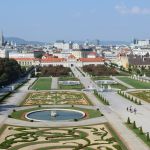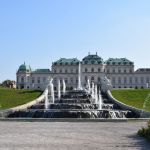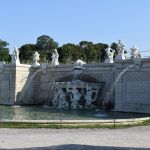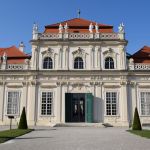Prince Eugene of Savoy was born in Paris in 1663, at the time of the Sun King. He was of a high born family but could not stay in Paris because of his mother. Prince Eugene’s mother had briefly been a mistress of the King before she married. It is said that she poisoned one of the ladies in waiting in the late 1670s because the king had fallen in love with the lady in waiting. She also threatened the king and fled France before her trial, leaving Prince Eugene behind. Because of this scandal, Prince Eugene was refused a position in the French army. In 1683, he moved to Vienna, where he eventually became commander-in-chief. With his wealth, he built the Belvedere, Italian for “beautiful view”.
Disclaimer: As we were not allowed to take pictures of original paintings, Egon Schiele’s painting and from WikiArt. Additionally, the picture of The Kiss by Klimt is a picture of the reproduction.
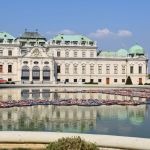
Upper Belvedere was built as Prince Eugene of Savoy's summer residence. Upon his death, the palace went to Prince's niece, Princess Maria Anna Victoria of Savoy. She, however, had no interest in it and sought to auction it off as soon as possible. The Belvedere has mainly served as a museum after that, except for the short period in which Archduke Ferdinand lived in the palace.
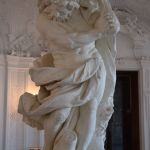
Sala Terrena in Upper Belvedere: The palace was built in baroque style, explaining the embellishments on the columns.
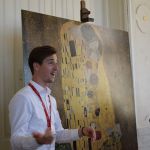
The Kiss by Gustav Klimt : When Gustav Klimt’s brother, Ernst, died, his wife (and Emilie Flöge’s sister) was left in his ward. He then began to spend more and more time at the Flöge household, leading to Klimt and Emilie's relationship. While they were never married, The Kiss is believed to be a painting of Gustav Klimt and his lover, Emilie Flöge. Couples come to the Belvedere and men propose to their girlfriends in front of it because it's an icon of love. It's covered in gold. It's a moment in love, a kiss. There are flowers. But it's actually not purely happy painting. The male figure’s head is pushed into the frame. His neck is crooked and thick. Gustav Klimt himself had a very large neck suggesting that this is a self-portrait. The female figure appears hesitant. She's not pushing him away but she's also not really pulling him closer. The male is wearing some type of robe colored in black and gold with a very boxy pattern to show masculinity. By contrast, the female is covered in colors and flowers. There is a yin yang effect: the female has a couple boxy areas by her shoulder while the male has a couple swirls in his dress. Further, Emilie was a fashion designer. She reacted against the traditional clothing, which was very restrictive, and designed very loose fitting clothing, like the ones in the painting. In the end, art can be interpreted in various ways. Some say that it's a depiction of the perfect love. Others claim that she's being forced into it and that she's uncomfortable. The truth is in the eye of the beholder.

The Family by Egon Schiele: Egon Schiele's father died of syphilis, which is an element that is reflected in his paintings, namely Death and the Maiden. Schiele paints in very dark colors with the subject generally distorted in some way. His wife died of the Spanish flu when she was six months pregnant. The Family is the last known portrait by Egon Schiele. It was unfinished at the time of Schiele's death. It's also one of the last paintings painted during the monarchy. The monarchy is somehow symbolized by the painting. Egon died three days after his wife and shortly before the end of the war, and the end of the monarchy.
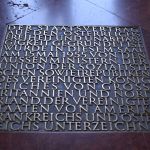
Inscription in Marble Hall: “The international treaty on Austria’s freedom and independence is created, was signed in this hall on the 15th of May, 1955 by the outside ministers of the Union of Soviet Socialist Republics, the United Kingdom of Great Britain and Northern Ireland, the United States of America, France and Austria’s allies.”
